The Wheelchair Guide
Your Wheelchair and Mobility Scooter Resource
Choosing the Right Type of Mobility Vehicle Lift
Saturday, December 5th, 2009
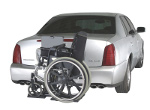 Vehicle Lifts are used to make it easier to transport a wheelchair or mobility scooter. When considering what type of vehicle lift to use, there are several factors that should be taken into account, including what type of mobility vehicle is being transported and what type of vehicle is being used. These factors will often help narrow down the options that are available to the wheelchair user, making it much simpler to select the right wheelchair lift.
Vehicle Lifts are used to make it easier to transport a wheelchair or mobility scooter. When considering what type of vehicle lift to use, there are several factors that should be taken into account, including what type of mobility vehicle is being transported and what type of vehicle is being used. These factors will often help narrow down the options that are available to the wheelchair user, making it much simpler to select the right wheelchair lift.
What Type of Mobility Vehicle is Being Transported
The type of mobility vehicle that is being transported is often the biggest factor that helps determine what type of vehicle lift to use. There are many different models of mobility vehicles, but they can usually be classified as manual wheelchairs, electric wheelchairs, and mobility scooters.
In the case of transporting a manual wheelchair, most people will simply fold it up and put it in their trunk. However, since manual wheelchairs can be rather heavy, sometimes lifting them into the back of the car can be difficult. Also, there is often simply not enough room in the car, so an external wheelchair lift is used. These are usually not motorized and attach to the hitch of a vehicle.
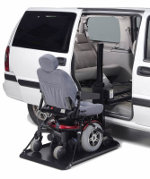 Of course, if you have a mobility scooter or an electric wheelchair, a manual wheelchair lift will not work. Instead, you would need to invest in a motorized wheelchair lift. In some cases, electric wheelchair carriers and mobility scooters carriers can be used interchangeably, but this is not always the case.
Of course, if you have a mobility scooter or an electric wheelchair, a manual wheelchair lift will not work. Instead, you would need to invest in a motorized wheelchair lift. In some cases, electric wheelchair carriers and mobility scooters carriers can be used interchangeably, but this is not always the case.
For example, often instead of a full platform, mobility scooter lifts will use a lift that has metal tracks, which are only large enough for the wheels of the scooter to fit into. When loading the scooter, the wheels will be driven into the tracks, which support the entire weight of the device. For three wheel scooters, the lift will have three tracks and for four wheeled scooters, there would be two tracks.
Some other lifts will have automatic hold down arms, which engage as the lift is being raised and hold the scooter in place without the need for tie-down straps. The automatic hold down arm works, because of the longer design of the mobility scooter, making contact with the floor portion where the use rests their feet. However, most electric wheelchairs will not work with this type of lift.
When in doubt, if the lift is labeled as an Universal Lift this means it will work with both electric wheelchairs and mobility scooters. Otherwise, it will often only work with one or the other.
What Type of Vehicle is Doing the Transporting
 The type of vehicle that will transporting the mobility vehicle is also important.
The type of vehicle that will transporting the mobility vehicle is also important.
For example, those that wished to use a passenger car have fewer options than those with a van or SUV. Typically, the only option would be a hitch mounted lift or a crane lift. The hitch mounted lift is simply inserted onto the vehicles hitch and either has its own battery pack or uses the vehicles power. Crane lifts are installed into the trunk of the car and simply hoist the wheelchair off the ground in the same manner a crane lifts a heavy load to the top of a building. One feature to look out for when shopping for crane lifts is Powered Rotation, which means the crane’s arm can be completely controlled electronically.
Those who have a SUV or van can also use the hitch mounted lift or the crane lift, but internal wheelchair lifts are also an option. These use a small platform that extends from the vehicle, allows the scooter or wheelchair to be driven onto the platform, then retracts, storing the wheelchair inside of the vehicle. These are most popular with vans, as by removing one of the rows of seats, the scooter can be stored directly behind the drives seat. In SUVs, internal lifts are used in the rear trunk area.
Those with trucks also have a few options and can of course use the crane or hitch mounted options described above. There are also several specially made truck lifts that are designed to lift the scooter off of the ground and into the bed of the pickup truck.
Where You Live or Where You Plan on Traveling to
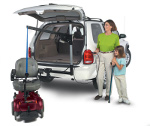 Yet another factor that helps determine what type of wheelchair lift is right, is where the person lives or where they plan on using the lift. For example, those who live in an area that gets a great deal of rain, snow, or other inclement weather, would probably want to go with a internal wheelchair lift. This way the wheelchair or scooter will be stored safely out of the weather.
Yet another factor that helps determine what type of wheelchair lift is right, is where the person lives or where they plan on using the lift. For example, those who live in an area that gets a great deal of rain, snow, or other inclement weather, would probably want to go with a internal wheelchair lift. This way the wheelchair or scooter will be stored safely out of the weather.
However, those who live in a more moderate climate would be able to use a hitch mounted wheelchair lift that stores the wheelchair outside of the vehicle. However, it is still usually recommended to invest in a cover for the wheelchair or scooter, to protect against sudden storms or road debris.
How to Transport a Wheelchair
Monday, November 2nd, 2009
As a result of the ADA and other legislation, many of the areas a wheelchair user wishes to go are made accessible. There are of course exceptions to the rule, but the overwhelming majority of businesses in the United States are wheelchair accessible. As a result, the most difficult part of using a wheelchair in public is generally getting it where you need it to be or transporting the wheelchair.
There are a number of different methods to transport a wheelchair, but often the most effective means is to use a vehicle wheelchair lift. Without a vehicle wheelchair lift, however, it is often still possible to transport a wheelchair.
Transporting the Wheelchair in the Trunk or Backseat
 Depending on the type of wheelchair, it is sometimes possible to simply store the wheelchair in the trunk of the vehicle or even in the back seat. This is easiest with manual wheelchairs, which are designed to be folded up when not in use.
Depending on the type of wheelchair, it is sometimes possible to simply store the wheelchair in the trunk of the vehicle or even in the back seat. This is easiest with manual wheelchairs, which are designed to be folded up when not in use.
Some electric wheelchairs and mobility scooters are also designed to be transported easily without a wheelchair lift. These mobility vehicles are usually called travel wheelchairs or travel scooters and are made to be taken apart easily, with no one piece weighing too much for a person to safely lift into their trunk. One drawback to this type of electric power chair or scooter, however, is that in order to reduce weight, a number of features are removed that are in other standard electric wheelchairs.
Using a Van Ramp
 Another option for transporting a wheelchair is to use a ramp system. There are a number of metal folding ramps available, which are designed to be used with the side door of a van. These allow the wheelchair to be driven directly into the van or to be operated by someone standing next to the wheelchair.
Another option for transporting a wheelchair is to use a ramp system. There are a number of metal folding ramps available, which are designed to be used with the side door of a van. These allow the wheelchair to be driven directly into the van or to be operated by someone standing next to the wheelchair.
While it is possible to use a ramp with other types of vehicles, this option works best with vans that have had at least one row of seats removed.
Ramps offer a cost effective wheelchair transport solution, but do not work with all vehicles and unless someone is there to help position the ramp, they can be difficult to use.
Using a Wheelchair Lift
Wheelchair lifts are more expensive than using a ramp, but are much easier to use independently. There are a number of wheelchair lift designs, but they can be broken down into interior wheelchair lifts and exterior wheelchair lift.
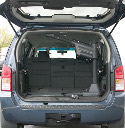 Interior wheelchair lifts are installed inside of the vehicle and store the wheelchair inside as well. There are a few different designs, but most either use a platform lift system or a crane lift system. The platform lift system allows the user to drive their wheelchair onto a small platform that extends from the vehicle. Then, once activated, the wheelchair lift will move the platform and wheelchair inside of the vehicle. You will often see this type of wheelchair lift in vans, but they can also be used in trucks and SUVs.
Interior wheelchair lifts are installed inside of the vehicle and store the wheelchair inside as well. There are a few different designs, but most either use a platform lift system or a crane lift system. The platform lift system allows the user to drive their wheelchair onto a small platform that extends from the vehicle. Then, once activated, the wheelchair lift will move the platform and wheelchair inside of the vehicle. You will often see this type of wheelchair lift in vans, but they can also be used in trucks and SUVs.
The other type of interior wheelchair lift is the crane lift, which is basically just a crane that attaches to the wheelchair and the raises it into the vehicle. Crane lifts can not be used with someone sitting on the wheelchair and it is sometimes necessary to partially disassemble the wheelchair before moving it into the vehicle.
One of the advantages of crane lifts is that they don’t take up much space, so they can be used in a car, where other wheelchair lifts would not work. A nice feature when shopping for a crane wheelchair lift is powered rotation, which means that the arm of the crane can be swiveled using a hand control. This makes it easier to swing the wheelchair into position.
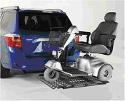 Exterior wheelchair lifts, on the other hand, almost always use a platform lift system, except unlike interior wheelchair lift, the wheelchair is stored outside of the vehicle. Exterior wheelchair lifts attach to the hitch of a vehicle, which means that they are very easy to install, don’t require modification to the vehicle, and do not take up any interior space.
Exterior wheelchair lifts, on the other hand, almost always use a platform lift system, except unlike interior wheelchair lift, the wheelchair is stored outside of the vehicle. Exterior wheelchair lifts attach to the hitch of a vehicle, which means that they are very easy to install, don’t require modification to the vehicle, and do not take up any interior space.